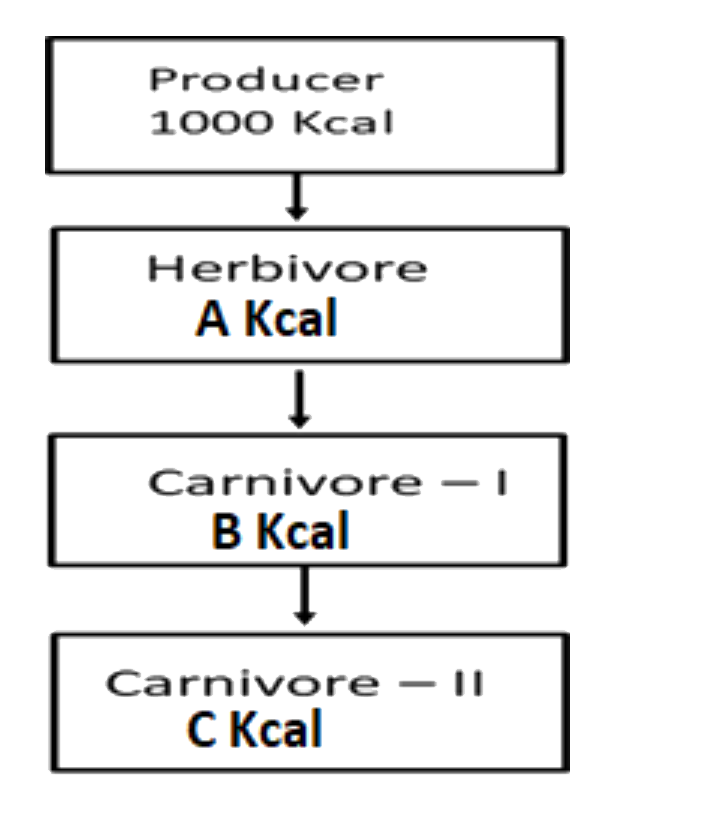10% Law - Our Environment
Step-by-Step Solution for the 10% Law - Our Environment
1. Understanding the 10% Law: The 10% Law, proposed by Riemann and Lindemann, states that when energy is transferred from one trophic level to the next in an ecosystem, only 10% of the energy is passed on to the next level.
2. Energy Transfer in Trophic Levels:
- In an ecosystem, energy flows from producers to various levels of consumers.
- Producers (like plants) capture energy from the sun through photosynthesis.
3. Example of Energy Flow:
- Let's consider a simple food chain:
- Producers: Plants
- Primary Consumers: Deer (herbivores)
- Secondary Consumers: Lion (carnivores)
4. Calculating Energy at Each Trophic Level:
- Assume 1000 Joules of solar energy reaches the plants (first trophic level).
- According to the 10% Law, plants will only utilize 10% of this energy:
- Energy absorbed by plants = 10% of 1000 Joules = 100 Joules.
5. Energy Transfer to Primary Consumers:
- The primary consumers (deer) will receive only 10% of the energy from the plants:
- Energy available to deer = 10% of 100 Joules = 10 Joules.
6. Energy Transfer to Secondary Consumers:
- The secondary consumers (lions) will receive only 10% of the energy from the deer:
- Energy available to lions = 10% of 10 Joules = 1 Joule.
7. Summary of Energy Flow:
- Producers (Plants): 1000 Joules (from the sun) → 100 Joules (available for herbivores)
- Primary Consumers (Deer): 100 Joules → 10 Joules (available for carnivores)
- Secondary Consumers (Lions): 10 Joules → 1 Joule (available for higher trophic levels)
8. Conclusion: The 10% Law illustrates the inefficiency of energy transfer in ecosystems, where only a small fraction of energy is available to higher trophic levels, leading to fewer organisms at each successive level.
- In an ecosystem, energy flows from producers to various levels of consumers.
- Producers (like plants) capture energy from the sun through photosynthesis.
- Let's consider a simple food chain:
- Producers: Plants
- Primary Consumers: Deer (herbivores)
- Secondary Consumers: Lion (carnivores)
- Assume 1000 Joules of solar energy reaches the plants (first trophic level).
- According to the 10% Law, plants will only utilize 10% of this energy:
- Energy absorbed by plants = 10% of 1000 Joules = 100 Joules.
- The primary consumers (deer) will receive only 10% of the energy from the plants:
- Energy available to deer = 10% of 100 Joules = 10 Joules.
- The secondary consumers (lions) will receive only 10% of the energy from the deer:
- Energy available to lions = 10% of 10 Joules = 1 Joule.
- Producers (Plants): 1000 Joules (from the sun) → 100 Joules (available for herbivores)
- Primary Consumers (Deer): 100 Joules → 10 Joules (available for carnivores)
- Secondary Consumers (Lions): 10 Joules → 1 Joule (available for higher trophic levels)
Similar Questions
Thermal power plants are inevitable in an industrial and densely populated country like ours. What harm do they do the environment ?Also mention any precaution that could be taken to save our environment.
View SolutionWhich is wrong with respect to our responsibility as a human being to protect our environment?
View Solution
Knowledge Check
In jume, the price of a DVD player that sells for $150 is increased by 10%. In july, the price of the same DVD player is decreased by 10% of its current selling price. What is the new selling price of the DVD player?
A140B148.5C150D152.5
Which is wrong with respect to our responsibility as a human being to protect our environment?
View SolutionIn which ways are bacteria useful to our environment and us?
View Solution10% law of energy transfer in food chain was given by:
View Solution10% law of energy transfer in food chain was given by:
View SolutionBased on a 10% law of enery transerfer, identify values for A, B and C in the figure given below.

View SolutionA certain sum of money amounts to Rs 23,400 in 3 years at 10% per annum simple interest. Find the amount of the same sum in 2 years and at 10% p.a. compound interest.
View SolutionIn a Young's double-slit experiment the fringe width is 0.2mm. If the wavelength of light used is increased by 10% and the separation between the slits if also increased by 10%, the fringe width will be
View Solution
